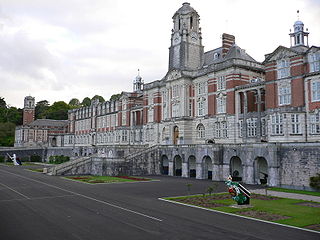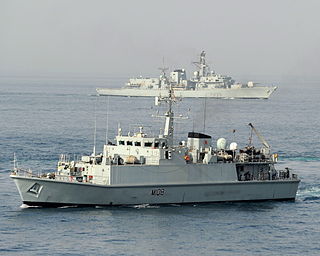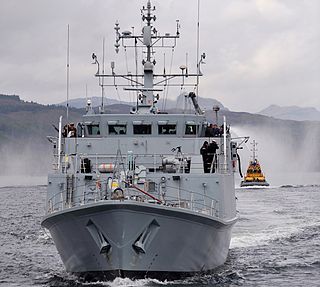
The Royal Norwegian Navy is the branch of the Norwegian Armed Forces responsible for naval operations of Norway, including those of the Norwegian Coast Guard. As of 2008, the Royal Norwegian Navy consists of approximately 3,700 personnel and 70 vessels, including 4 heavy frigates, 6 submarines, 14 patrol boats, 4 minesweepers, 4 minehunters, 1 mine detection vessel, 4 support vessels and 2 training vessels.

Britannia Royal Naval College (BRNC), commonly known as Dartmouth, is the naval academy of the United Kingdom and the initial officer training establishment of the Royal Navy. It is located on a hill overlooking the port of Dartmouth, Devon, England. Royal Naval officer training has taken place in Dartmouth since 1863. The buildings of the current campus were completed in 1905. Earlier students lived in two wooden hulks moored in the River Dart. Since 1998, BRNC has been the sole centre for Royal Naval officer training.

The Sandown class is a class of fifteen minehunters built primarily for the Royal Navy by Vosper Thornycroft. The Sandown class also serve with the Royal Saudi Navy, the Estonian Navy, and the Ukrainian Navy. The first vessel was commissioned into Royal Navy service on 9 June 1989 and all the British ships are named after coastal towns and cities. They have a secondary role as offshore patrol vessels.

HMS Bronington is a Ton-class minesweeper of the Royal Navy, launched on 19 March 1953. This mahogany-hulled minesweeper was one of the last of the "wooden walls".
HMS Cromer, after the Norfolk town of Cromer can refer to any of three Royal Navy ships:

HMS Duncan is the sixth and last of the Type 45 or Daring-class air-defence destroyers built for the Royal Navy and launched in 2010. Duncan is named after Adam Duncan, 1st Viscount Duncan, who defeated the Dutch fleet at the Battle of Camperdown on 11 October 1797. The destroyer has served in the Mediterranean, Black, and Caribbean Seas, and in 2019 was deployed to the Persian Gulf in response to increased tensions with Iran in the region.

The Norwegian armed forces in exile were remnants of the armed forces of Norway that continued to fight the Axis powers from Allied countries, such as Britain and Canada, after they had escaped the German conquest of Norway during World War II.

HMS Grimsby was a Sandown-class minehunter of the British Royal Navy, serving from 1999–2022, and the second ship to bear the name.

HMS Ledbury, the second ship of the name, is a Hunt-class mine countermeasures vessel of the Royal Navy. She was launched in December 1979 and commissioned on 11 June 1981, the second ship of her class. She cost £65 million at time of building, which was at the time the most expensive cost-per-metre for any class of ship built by the Royal Navy. Most of this cost went into the research and development of Ledbury's glass reinforced plastic hull.

HMS Cattistock, the third ship of this name, is a Hunt-class mine countermeasures vessel of the Royal Navy. She was launched in 1981 and commissioned on 5 March 1982, the third ship of her class.

HMS Penzance is a Sandown-class minehunter commissioned by the Royal Navy in 1998. She is named after the seaside town of Penzance in Cornwall, and is the fourth vessel to bear the name.

HMS Pembroke is a Sandown-class minehunter of the Royal Navy. She was the second ship launched of the second batch of the class, which had several improvements over the first five ships built. The ship was posted for three years to the Persian Gulf between 2009 and 2012. Pembroke has since been deployed in international exercises and in historic ordnance detection in home waters. Pembroke was the first of the Royal Navy’s Mine Countermeasures Vessels to be fitted with the Oceanographic Reconnaissance Combat Architecture combat system to replace the previous NAUTIS combat system in early 2020.

HMS Ramsey was a Sandown-class minehunter of the British Royal Navy. Like other vessels of the Sandown class, Ramsey was built of glass-reinforced plastic and other non-magnetic materials so that her hull does not trigger naval mines as easily as standard warships.

Sublocotenent Ion Ghiculescu (M270) is a Sandown-class minehunter of the Romanian Naval Forces. She was built as HMS Blyth (M111), for the Royal Navy, the eleventh of this class of twelve Single-Role Minehunters (SRMH) ships. She was laid down on 30 May 1999 by Vosper Thornycroft at their Woolston, Southampton shipyard, launched in May 2000 and entered service for the Royal Navy in February 2001. She was the second vessel to carry this name, the first being a Bangor-class minesweeper of the Second World War, wearing pennant number J15. Blyth served in the Middle East as part of the 9th Mine Countermeasures Squadron.

HMS Shoreham was a Sandown-class minehunter of the British Royal Navy. She was the fifth vessel to bear the name. From 2018 to 2021, Shoreham was deployed at UKNSF Bahrain together with three other mine countermeasures ships as part of 9 Mine Countermeasures Squadron on Operation Kipion. In 2022 she was decommissioned and was transferred to Ukraine.
Five ships of the Royal Navy have been named HMS Hindustan or Hindostan, after the old name for the Indian subcontinent:

HMS Forth is a Batch 2 River-class offshore patrol vessel in active service with the Royal Navy. Named after the River Forth, she is the first Batch 2 River-class vessel to be built. She was commissioned into the Royal Navy on 13 April 2018, following a commissioning ceremony at her homeport HMNB Portsmouth. In January 2020 she replaced HMS Clyde as the Falkland Islands patrol ship.

HMS Trent is a Batch 2 River-class offshore patrol vessel, named after the River Trent. This is the sixth Royal Navy ship named Trent. She is the third Batch 2 River-class vessel to be commissioned and is forward deployed to Gibraltar for operations in the Mediterranean and Gulf of Guinea.
















